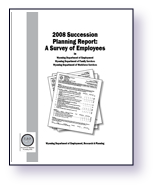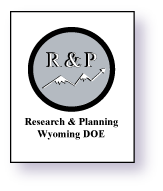Chapter 1: Introduction
by: Dr. Mark A. Harris, Sociologist
Purpose of the Study
 This project is the culmination of efforts that began in 2007 among top management personnel in several state agencies. The purpose of this study is to ascertain and understand employee plans and behavior as they relate to working in state government. The scope of this research effort includes both employees nearing and contemplating retirement and employees at risk of leaving for reasons other than retirement. Given the aging of state government employees and the unique energy-driven market expansion currently at play in the state, developing an ongoing research agenda as it applies to employee succession planning has become of substantial concern in terms of both the scope of the challenge and what can realistically be done about it. The need for succession planning is acute in both the public and private sectors and is especially relevant where incumbent knowledge, skills, and abilities (KSAs) are sophisticated. This study explores these issues among two medium-size and one large state agency. An additional purpose of this inquiry is to serve as a pilot and feasibility study for possible expansion to all state government agencies.
This project is the culmination of efforts that began in 2007 among top management personnel in several state agencies. The purpose of this study is to ascertain and understand employee plans and behavior as they relate to working in state government. The scope of this research effort includes both employees nearing and contemplating retirement and employees at risk of leaving for reasons other than retirement. Given the aging of state government employees and the unique energy-driven market expansion currently at play in the state, developing an ongoing research agenda as it applies to employee succession planning has become of substantial concern in terms of both the scope of the challenge and what can realistically be done about it. The need for succession planning is acute in both the public and private sectors and is especially relevant where incumbent knowledge, skills, and abilities (KSAs) are sophisticated. This study explores these issues among two medium-size and one large state agency. An additional purpose of this inquiry is to serve as a pilot and feasibility study for possible expansion to all state government agencies.
Agencies and Employees Involved
The research model presented here is based primarily on earlier work developed by Research & Planning (R&P) while conducting succession planning research on Department of Employment (DOE) employees in fall 2006 (see full report). Although five agencies initially expressed interest, this publication focuses again on DOE employees and is extended to workers in the Department of Family Services (DFS) and the Department of Workforce Services (DWS). A total of 1,306 state employees were surveyed with 971 responding for an overall response rate of 74.3%.
Demographic and Market Challenges
The chapter on demographics clearly shows that over the next several decades the state will face an increasing number of retirements (see additional demographic detail). Many will take place in mission-critical and management positions (see “Occupations of Concern”). In addition, previous research has indicated that the state’s existing pay plan may not adequately account for market forces driving Wyoming’s economy (Harris, 2006), thus leading to additional turnover among state employees. Failure to address demographic and market challenges likely means an increasing amount of seasoned talent loss, as well as the direct and indirect costs that accrue to state agencies from unnecessary employee turnover (for additional detail on turnover see also quarterly TRENDS issues). It should be noted that the agencies studied have a higher percentage of female employment than some other agencies and state government as a whole. This demographic factor likely impacts the results of this study and affects the degree to which the results can be generalized to all of state government. Factors such as child care, school age children, care of older parents, gender discrimination, limited high paying work opportunities outside of state government, as well as other factors may be of greater concern to employees in these agencies as compared to other agencies with a different demographic profile.
The Value of Multiple Methods
R&P is in a unique position for producing succession planning research. Survey research provides a limited and somewhat costly alternative for collecting data. Moreover, interpreting the relevance (results) of responses for behavior and policy can be less than straightforward. However, it is invaluable in many circumstances when no other data sources currently exist. This is often the case when researching opinions and behavioral intentions. R&P has extensive history in producing quality survey research findings (see a recent survey on Wyoming nurses).
R&P, due to its association with the Unemployment Insurance (UI) program and agreements with other state agencies, has the advantage of longitudinal wage and demographic data on a near census of all workers in the state from 1992 to the present. These data mean that R&P can determine the work history of all employees for an extensive time frame. Given the ongoing nature of the data collection strategy, results from administrative data research can be updated at minimal cost on a quarterly basis to ascertain current trend development.
R&P has also pioneered research into combining survey and administrative data to take advantage of research possibilities not available from either source separately. The combination of survey and administrative data on research subjects means that R&P, for example, can verify responses to survey questions to determine which questions are most predictive of various workforce behaviors. As an example, R&P can, over time, verify the actual number of respondents who left their organization after stating their intent to do so (known as question predictive validity; see Table 1). By so doing we can refine what is and is not important for understanding and predicting turnover behavior.
Note on Internal and External Factors
Given that state agencies do not operate independently of the larger bureaucracy of which they are a part, the reader must be aware that state agencies will have limited ability to address certain issues. For example, loss of employees to better paying jobs in the private sector may be beyond the control of an agency operating within the context of federal budget cutbacks or an inflexible centralized pay plan. On the other hand, perceived unfairness in the way work is distributed in an agency or unethical behavior among management personnel, among other topics, are factors that can be addressed directly by an agency. The intent of this report is not to grade agencies on these internal and external factors—particularly since they have varying missions and operate under different criteria and circumstances. Instead, this report is intended to help agency management better ascertain employee opinions, behavioral intentions, and actual historical behavior. Comparisons are meant to be instructive and informative and to provide sufficient context so an agency can act where it is able to do so and petition where it is not. Additionally, problems common to the three agencies can potentially be addressed with coordinated efforts.
Tips on Report Use
This report presents a number of statistics. Our intent from the outset has been to use the most rigorous methods available while balancing the need for understandability. As such, a broad variety of statistics are presented, ranging from univariate statistics to more complex multivariate (predictive) statistics. Univariate statistics are the most simplistic and are intended to summarize information within a single category (e.g., how DFS employees responded to a single question). Univariate statistics help readers to quickly grasp the size and shape of many responses to a particular question (e.g., the average age of all respondents). At other times bivariate statistics are used wherein, for example, the distribution of the responses to a question are compared across multiple agencies (e.g., do responses to question X differ between DFS and DOE?). Bivariate statistics are useful for illuminating differences (determined by formal statistical tests) but don’t ascertain “why” differences exist. At other times in this report, more sophisticated multivariate tests were conducted to ascertain how multiple factors were related to a particular response (e.g., do wage dissatisfaction, few advancement opportunities, and dissatisfaction with management all predict an intent to exit employment?), and determine which are more powerful or salient predictors.
References
Harris, M. A. (2006). State employee compensation: A comparison to the local market. Wyoming Labor Force Trends, 43(3), 1-7. From
http://doe.state.wy.us/LMI/0306/toc.htm

